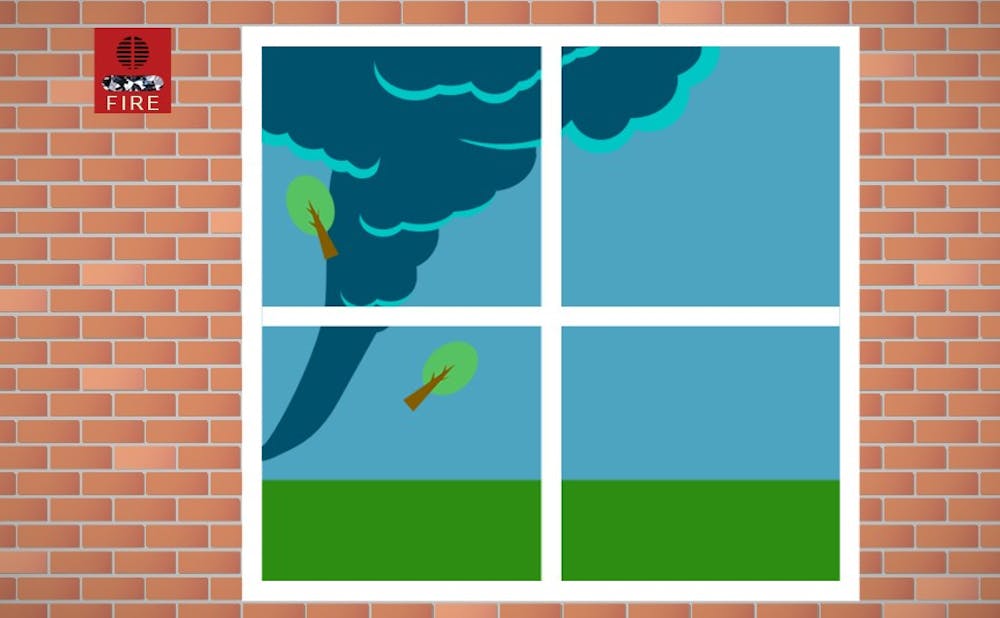For most Duke students hailing from around the United States and the world, a tornado is a foreign entity. But not for sophomore Todd Murphy.
Growing up in Texas, Murphy was no stranger to tornado threats. In the past decade, north and central Texas alone has seen more than 240 tornadoes, according to the National Weather Service. Murphy himself has been through many tornado warnings, yet the tornado warning at Duke a two weeks ago still took him by surprise.
He woke up to his phone’s emergency alert system, he wrote in an email. Murphy and his roommates completely slept through the outside siren. Immediately, he sought more information.
"When I turned on the news, the weatherman said there was rotation only two miles away from me, which for a tornado, is very close," he wrote.
For someone who has been through multiple tornado warnings, Murphy wondered why there wasn't an alarm inside his building.
Alarms inside buildings mean evacuation, wrote Kyle Cavanaugh, vice president for administration, who is also Duke's emergency coordinator.
"Evacuation is not what we want people doing during tornadoes," he wrote.
At schools Murphy had previously attended, there was a separate building alarm to indicate tornadoes, a system he said Duke should implement to ensure students hear it.
"I think Duke, if they don’t have it in their plan already, should implement an indoor warning system," he wrote. "Because we are living on Duke’s campus, I assume Duke is liable for the well-being and safety of its students. I’d rather have an indoor alarm sound that let me know there is a tornado than sleep through it."
Perhaps one reason Murphy—who lives in a 300 Swift apartment—wasn't woken up the outdoor siren is because he was just far enough from one of the nine outside warning sirens.
These sirens are located off West Markham Avenue in an area near the tennis courts and Pegram-Carr parking lot and near Epworth residence hall on East Campus, and the Central Campus sirens are found off Pace Street and Oregon Street and near Anderson Street across from the Duke Gardens.
West Campus sirens can be found next to the Allen Building, off Bassett Drive and near the Sanford School of Public Policy, whereas Duke Medicine sirens are behind the North Building parking area and at the corner of Fulton and Elder Streets.
For students who may not have heard the outside siren, Cavanaugh explained that Duke has a contingency plan.
"During specific events Duke has a multilayered and redundant notification system," he wrote. "It includes, email, text, social media, digital signs, web sites and if needed, sirens. Each of the systems are tested regularly as part of the institutions emergency management system."
Two weeks ago during the tornado warning, the University sent out two Duke alerts—one at 7:37 a.m. that cleared 15 minutes later and one at 8:17 a.m that was canceled about half an hour later. Both Cavanaugh and Murphy said that an immediate notification to the campus was vital.
"Tornadoes are fast developing and always changing," Cavanaugh added. "The immediate need is to get the initial notification out."
Editor's note: This article is a product of a service run by The Chronicle called Chronquiry. A reader submitted a question, other readers voted on the question and The Chronicle got the answer. If you have a question you would like answered about anything related to Duke, visit dukechronicle.com/page/chronquiry or submit a question below:
Get The Chronicle straight to your inbox
Signup for our weekly newsletter. Cancel at any time.
Class of 2019
Editor-in-chief 2017-18,
Local and national news department head 2016-17
Born in Hyderabad, India, Likhitha Butchireddygari moved to Baltimore at a young age. She is pursuing a Program II major entitled "Digital Democracy and Data" about the future of the American democracy.

